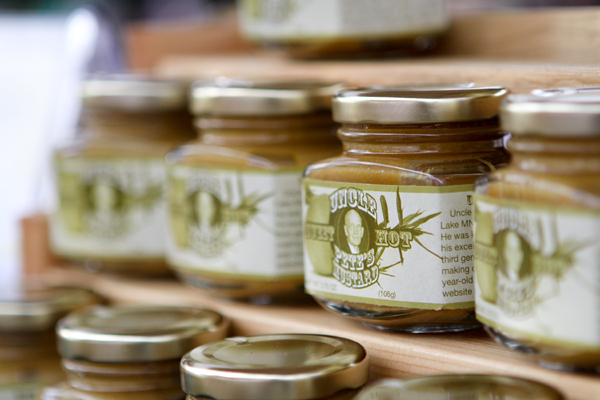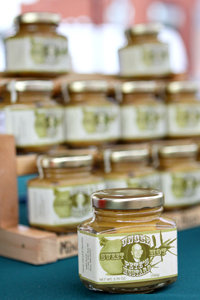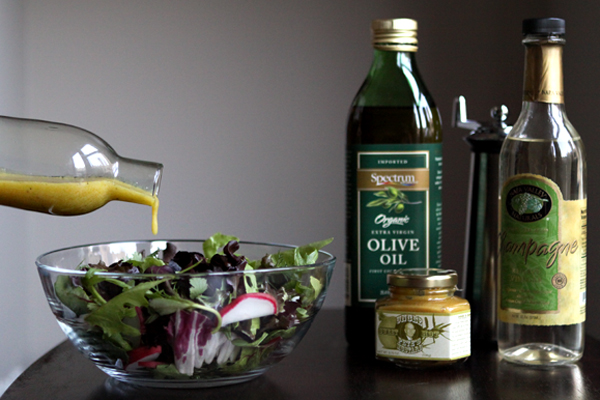
How is it that some recipes become proprietary and others do not? It seems less about the quality of the recipe than nostalgia — for a point in a time, a person, a place, or simply a flavor.
After all, we have all known perfectly delicious recipes, real crowd-pleasing keepers, to be published broadly and without ceremony among friends, relations, and willing strangers. And then again, there are humble recipes of few and simple ingredients that get tucked away in coffer boxes, their cards taken out and copied but once or twice a generation and delivered with all the seriousness and joy of a family jewel.
Uncle Pete’s Mustard is one of those treasures, a secret concoction — of the crowd-pleasing keeper variety, but more about that later — passed down through four generations of producer Tom Dietman’s family.
The mustard emigrated from Poland in 1875 with Dietman’s maternal great grandparents, the Janochoskys, who may not have thought of it as rarefied. It lived in their pantry as a staple, trotted out with every meal the way some families put salt, pepper, and butter on the table.
Somewhere along the line, however, their son Pete realized there was something special about the family’s table mustard. A carpenter by trade and an avid gardener, he was apparently not much of a cook, but did enjoy making small batches of sauerkraut and mustard to eat and give away to visiting friends and family; people came back for the mustard. “He kind of became known as the mustard man,” says Dietman. “That started up some foot traffic to his house, if you will; people came just to get the mustard. They’d ask him for the recipe, but he wouldn’t release it.”

Dietman was five when his great uncle passed away, so his memories of Pete are spare, a child’s vague impressions supplemented with family anecdotes. “I remember laughing a lot,” says Dietman. “He had a great sense of humor — kind of mischievous as my mother describes it.”
For example, Uncle Pete’s wife, Annie, did not understand the chemistry of Tom & Jerry drinks, wherein the bulk of the liquor sinks below the frothy cream. “So she’d drink the top and give the bottom to Uncle Pete,” says Dietman. “He had it all planned out: ‘Annie, I’ll take care of the bottom half — I know you don’t like it.’ She’d always question how they hit him so hard.”
Just before he died, Uncle Pete passed his secret mustard recipe, and all its associated duties, not to his niece, Dietman’s mother, but to her husband Donny. They had a close relationship, but Dietman thinks the decision was probably based on the latter expressing fears about the future. “My dad probably asked him, ‘What are you going to do? When you’re gone, we might need some mustard,’” says Dietman.
As a butcher, Donny’s specialty was sausage, but at home he pretty much stuck to mustard. “People would leave the house when he did it,” says Dietman. “Not because he didn’t want them to know the recipe but because they couldn’t take the fumes. It’s like, ‘Ah! Dad’s making mustard, we gotta go outside!’”
Thirty or so years later, in keeping with tradition, Donny passed his son the mustard recipe. “You know, Dad had sausage and mustard, so we’d get together and that’s what he’d teach me,” he says. “I’d go a couple of years without making it and then we’d get together again.”
So was Dietman excited to have the recipe? “Um. Yeah. I mean, it was intriguing or unique to have this secret recipe,” he says, “but I didn’t run with it, I wasn’t like, ‘Ha hah! Now I have the secret recipe!’ It was more like a warm fuzzy; now I have Uncle Pete’s recipe and it’s my job to make the mustard.”
It didn’t occur to Dietman to make mustard his day job for several years.
Although a hotel acquisitions manager for 25 years, Dietman was working as an independent mortgage broker when the economy went south and the real estate market went flat. Dietman says he quickly realized he needed both an income and something to do with his days — and that drove him to explore the mustard business.
“People had encouraged first my father and then me to take it to market,” Dietman says. “So, when the phone quit ringing, I said, ‘Now I have some time on my hands, let’s pursue it.’”
Dietman initially took 500 1.5-ounce samples to different Minnesota meat markets. Each sample came with a blind survey that asked questions about flavor and interest – if the mustard becomes available, would you like me to email you a list of places where you can purchase it?
The survey yielded a 27 percent return rate, which marketing folks will tell you is remarkable. On a scale of 1 to 10, with 10 being the best, Uncle Pete’s averaged an eight. Dietman, it seems, was in business.

Today, Dietman and his family produce around 3,500 jars of mustard a month, and Uncle Pete’s is widely available at co-ops and meat markets around the state. It’s also used by several Twin Cities restaurants, including HauteDish, The Strip Club, White Bear Yacht Club, and FireLake Grill House. Stickney Hills Dairy has just introduced a Zesty Mustard chevre log flavored with it, and Uncle Pete’s is the official mustard of the St. Paul Saints, the St. Cloud River Bats, and the Brainerd Lunkers.
So what does it taste like? The initial flavor is honey sweet, then it gets hot, a horseradish kind of hot that goes straight up into your head and then is gone, leaving only a very mild, savory garlic flavor.
“We call it the Polish wasabi,” laughs JD Fratzke, chef and managing partner at the Strip Club. “The first time I ate it, I took a big spoonful, shoved it in my mouth, and the front of my face blew out!”
Fratzke’s family has been in the Minnesota River Valley for generations, but they originally emigrated from Prussia, and Uncle Pete’s Mustard puts him in mind of sauerkraut, sausages — and his grandparents. “Especially my grandfather, he was a huge fan of horseradish,” he says. “As Germans, I think it’s hardwired into our DNA.”
Uncle Pete’s is featured on the Strip Club’s small plate Salumi Alla Via Maria, which includes ciabatta, provolone, salumi, and pickled asparagus. It’s also whipped into crème fraiche with ginger, lime, and beets and served with steak. Occasionally, it turns up in vinaigrette.
In each of these dishes, Fratzke says, the mustard provides an element of the flavor balance he’s always looking for — that sweet, tart, salty, sour, spicy thing — but it’s also reminiscent of the Old World, Early American experience the restaurant is trying to evoke.
“What makes it so great is that it’s not just that kitschy hot flavor,” Fratzke says. “It’s not a French’s, it’s a true mustard. When you add it to the cream, that little bit of fat helps the flavors linger, so it doesn’t have quite as much punch, but you can taste the tangy tart flavor of the mustard, which is accentuated by the horseradish. It’s awesome.”
Dietman says Uncle Pete’s pairs well with flavorful meats and fish, as well as salty foods, such as pretzels and ham. “It’s like the Tabasco of the mustard world,” he adds. “On its own, Tabasco isn’t necessarily exciting, but when you add it to your other cooking ingredients it can do neat stuff to your flavors. Well, it’s the same with Uncle Pete’s.”
“It’s especially good element in marinades,” he adds. “It has a high vinegar content, which breaks down the protein in meats, so it creates really tender poultry or pork.”
In keeping with Fratzke comments, we liked how the mellow, mustardy side of Uncle Pete’s came out when we mixed it with olive oil in a simple vinaigrette, which we divulge at the end of the story — thus assuring it will never be a family secret, despite its tastiness.
It was lovely on a bed of microgreens tossed with green onions, radish, dill, parsley, and marigolds.
For more recipes and ideas, check out the Uncle Pete’s website.

Vinaigrette with Uncle Pete’s Mustard
6 tbsp olive oil
2 tbsp champagne vinegar
4-5 tsp Uncle Pete’s Mustard
½ tsp salt
Pepper to taste

Yay! More people need to know about this amazing mustard!! It makes the crab cakes at WBYC taste spectacular!
The first time I tried the mustard was at a Saints game and bought a bottle on the way home…it’s the best!!
Most unique mustard you will ever find. I started out using it as a condiment, but the recipe ideas for sauces, dressings, etc are endless.
A nice mustard flavor with a little kick; not overly spicy, but just the right blend of sweet and tangy. It’s delicious!
If you haven’t tried it yet…. you need to! I wasn’t a big mustard fan before but this is unreal.
Peter and Annie lived around the corner from my Grandmother for 50
years, 15th Ave N in St.Cloud Minnesota. They would play 500 and canasta every week. Pete actually gave my father, Clem Rosemark,
the recipe, the really HOT one with no sugar, and we have it but not the precise ratios, close though. He would give it out every Christmas with Polish sausage and we couldn’t wait. The picture of Pete on the jar is amazing. He was always such a kind man.
Where Can I buy it?